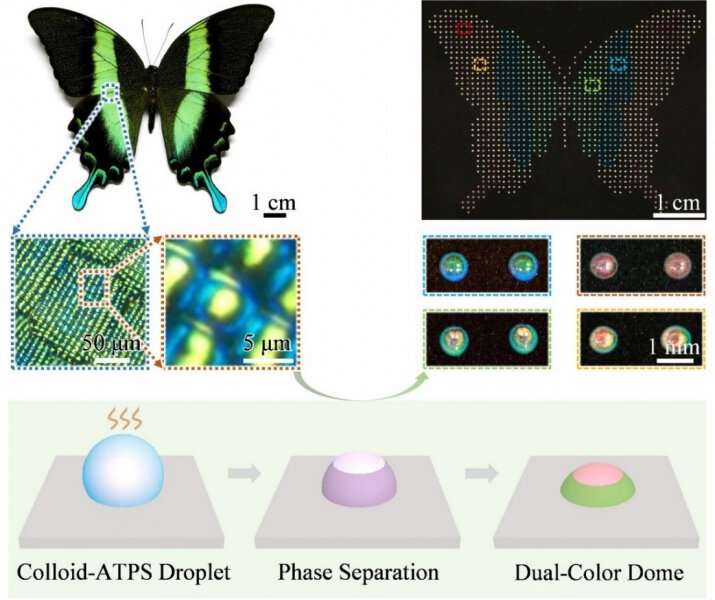Biomimetic dual-color domes programmable for encryption

Many organisms in nature have evolved spots with two structural colors on their bodies, like the Papilio Palinurus butterfly. The green color on its wings derives from the turquoise-yellow dual color spots.
Imitation of such dual-color spots—which are related to camouflage, message delivery, and thermoregulation in these species—has inspired designs of functional materials in many industrial areas. However, the construction of the dual-color spots suffers from complicated processes, expensive equipment, as well as multiple predesigned building blocks.
Recently, a group of researchers made a key breakthrough in fabricating dual-color domes. The team was led by Professor Anderson Shum from the Department of Mechanical Engineering at the University of Hong Kong (HKU) and their collaborators, Professor Yanlin Song and Associate Professor Huizeng Li, from the laboratory of the Green Printing in the Institute of Chemistry, Chinese Academy of Sciences. They have proposed an innovative strategy to self-assemble different nanostructures in a one-pot method using one type of building block. The work has been published in Nano Letters.
Professor Shum's team found that the evaporation of an aqueous two-phase system (ATPS) droplet could trigger the liquid-liquid phase separation to form two separated membrane-less compartmentalization, associating with non-uniform partitioning of solutes in different phases.
Taking advantage of the partitioning of solutes in phase-separated ATPS droplets and the droplet inner flow associated with the drying process, the team found that mono-sized nanoparticles would be non-uniformly distributed in two phases and self-assemble into photonic crystals with two different colors. The resultant color is highly programmable by regulating the concentration of the colloids. Enabled by the programmable binary color information, encryption with a high volume of contents was designed by the researchers, indicating the potential application of the dual-color domes in message encryption, storage, and delivery.
The meaning of this work is not limited to the construction of dual-color domes. The work provides a novel approach to constructing inhomogeneous nanostructures. It is also important for understanding the physical principles underlying the process of non-uniform self-assembly, which would drive inspiration for the spontaneous construction of sophisticated inhomogeneous nanostructures.
More information: Chang Li et al, One-Pot Self-Assembly of Dual-Color Domes Using Mono-Sized Silica Nanoparticles, Nano Letters (2022). DOI: 10.1021/acs.nanolett.2c01090
Journal information: Nano Letters
Provided by The University of Hong Kong





















